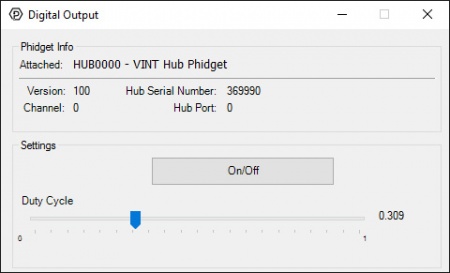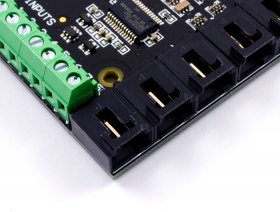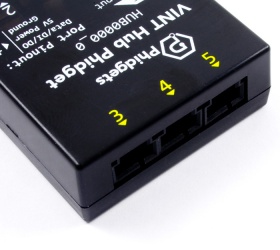Phidgets Connectors: Difference between revisions
| Line 36: | Line 36: | ||
'''Ratiometric''' sensors output a signal that is proportional to the amount of voltage used to power them. For example, a 0-100°C ratiometric temperature sensor that is powered by a 4.5V supply will output a voltage signal proportional to that 4.5V. So if it's measuring 50°C, which is half of it's full measurement range, it would output 2.25V (half of 4.5V). If the power supply to this sensor changes even slightly, that 2.25V signal will also change slightly. Thus, in order to read a ratiometric sensor properly, you must constantly compare the voltage signal reported by the sensor to the voltage of the power supply that's powering the sensor. | '''Ratiometric''' sensors output a signal that is proportional to the amount of voltage used to power them. For example, a 0-100°C ratiometric temperature sensor that is powered by a 4.5V supply will output a voltage signal proportional to that 4.5V. So if it's measuring 50°C, which is half of it's full measurement range, it would output 2.25V (half of 4.5V). If the power supply to this sensor changes even slightly, that 2.25V signal will also change slightly. Thus, in order to read a ratiometric sensor properly, you must constantly compare the voltage signal reported by the sensor to the voltage of the power supply that's powering the sensor. | ||
In the case of a Phidgets Analog Input or VINT Hub Port, opening the device in '''VoltageRatioInput''' mode will automatically handle this, and provide you with a voltage ratio which ranges from 0 to 1 V/V (volts per volt). '0' denotes that the sensor is sending back a signal that is 0% of the voltage it's being provided, and '1' denotes that the sensor is sending back a signal that is 100% of the voltage it's being provided. In the temperature sensor example described earlier, the VoltageRatioInput object will report a ratio of 0.5 V/V, since 2.25V is half of 4.5V. | In the case of a Phidgets Analog Input or VINT Hub Port, opening the device in '''VoltageRatioInput''' mode will automatically handle this, and provide you with a voltage ratio which ranges from 0 to 1 V/V (volts per volt). '0' denotes that the sensor is sending back a signal that is 0% of the voltage it's being provided, and '1' denotes that the sensor is sending back a signal that is 100% of the voltage it's being provided. In the temperature sensor example described earlier, the VoltageRatioInput object will report a ratio of 0.5 V/V, since 2.25V is half of 4.5V. You can use this ratio in combination with a formula from the sensor's datasheet or User Guide in order to convert it into the proper units. | ||
For any sensors sold at Phidgets, you can set the {{Code|SensorType}} property to have this conversion done automatically, since the libraries are loaded with all of the equations. Have a look at the {{Code|SensorType}} enumeration in the {{Phidget22API}} for a complete list of sensors that this can be done with. | |||
=== VoltageInput === | === VoltageInput === | ||
| Line 43: | Line 45: | ||
'''Non-Ratiometric''' sensors, on the other hand, don't care about how much voltage is being supplied to them, as long as it's within the specified range required to power them. This is because the sensor has a built-in regulator to ensure that it's getting a more-or-less steady supply. | '''Non-Ratiometric''' sensors, on the other hand, don't care about how much voltage is being supplied to them, as long as it's within the specified range required to power them. This is because the sensor has a built-in regulator to ensure that it's getting a more-or-less steady supply. | ||
To interface a non-ratiometric sensor, you can open your Phidgets Analog Input or VINT Hub port in '''VoltageInput''' mode, and you'll simply get data from the sensor in the form of a 0-5 volt value. Again, you can convert this voltage into a useful value using the equation found in the sensor's datasheet or User Guide. | |||
For any sensors sold at Phidgets, you can set the {{Code|SensorType}} property to have this conversion done automatically, since the libraries are loaded with all of the equations. Have a look at the {{Code|SensorType}} enumeration in the {{Phidget22API}} for a complete list of sensors that this can be done with. | |||
=== DigitalInput === | === DigitalInput === | ||
Revision as of 21:10, 10 April 2017
Physical Connectors
Phidgets Analog Input
Phidgets Analog Inputs are designed to connect to simple sensors that report their data in the form of a 0-5V analog signal. There are two types of sensors that fall under this category: Ratiometric and Non-Ratiometric. Each Analog Input channel can be opened with either the VoltageRatioInput object or the VoltageInput object, thus supporting these two different types of sensors. |
Phidgets VINT Hub Port
Phidgets VINT Hub Ports are primarily designed to connect to Phidgets VINT devices, which can be sensors, controllers, adapters, or data acquisition units. VINT devices use a digital protocol to communicate their data back to the VINT Hub via the VINT Hub Port. Each VINT Hub Port can also be opened with the following objects:
|
Software Objects
VoltageRatioInput
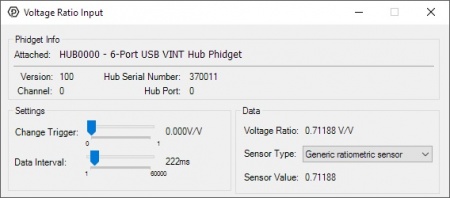
Ratiometric sensors output a signal that is proportional to the amount of voltage used to power them. For example, a 0-100°C ratiometric temperature sensor that is powered by a 4.5V supply will output a voltage signal proportional to that 4.5V. So if it's measuring 50°C, which is half of it's full measurement range, it would output 2.25V (half of 4.5V). If the power supply to this sensor changes even slightly, that 2.25V signal will also change slightly. Thus, in order to read a ratiometric sensor properly, you must constantly compare the voltage signal reported by the sensor to the voltage of the power supply that's powering the sensor.
In the case of a Phidgets Analog Input or VINT Hub Port, opening the device in VoltageRatioInput mode will automatically handle this, and provide you with a voltage ratio which ranges from 0 to 1 V/V (volts per volt). '0' denotes that the sensor is sending back a signal that is 0% of the voltage it's being provided, and '1' denotes that the sensor is sending back a signal that is 100% of the voltage it's being provided. In the temperature sensor example described earlier, the VoltageRatioInput object will report a ratio of 0.5 V/V, since 2.25V is half of 4.5V. You can use this ratio in combination with a formula from the sensor's datasheet or User Guide in order to convert it into the proper units.
For any sensors sold at Phidgets, you can set the SensorType property to have this conversion done automatically, since the libraries are loaded with all of the equations. Have a look at the SensorType enumeration in the Phidget22 API for a complete list of sensors that this can be done with.
VoltageInput
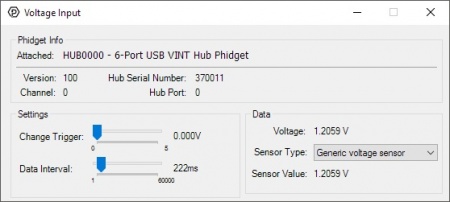
Non-Ratiometric sensors, on the other hand, don't care about how much voltage is being supplied to them, as long as it's within the specified range required to power them. This is because the sensor has a built-in regulator to ensure that it's getting a more-or-less steady supply.
To interface a non-ratiometric sensor, you can open your Phidgets Analog Input or VINT Hub port in VoltageInput mode, and you'll simply get data from the sensor in the form of a 0-5 volt value. Again, you can convert this voltage into a useful value using the equation found in the sensor's datasheet or User Guide.
For any sensors sold at Phidgets, you can set the SensorType property to have this conversion done automatically, since the libraries are loaded with all of the equations. Have a look at the SensorType enumeration in the Phidget22 API for a complete list of sensors that this can be done with.
DigitalInput
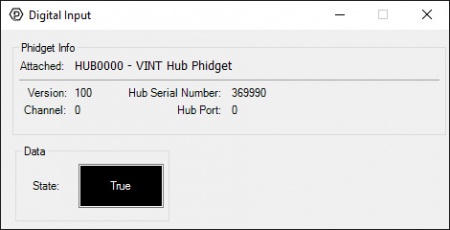
DigitalOutput
